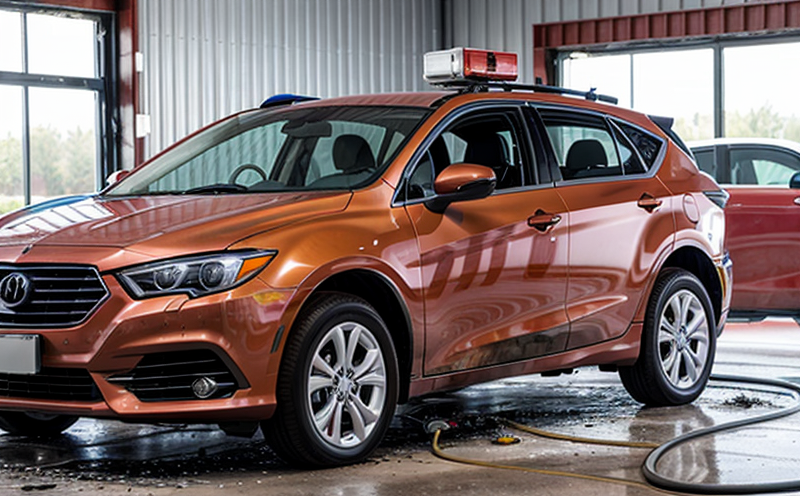Reaction-to-Fire Testing of Automotive Roof Linings
The automotive industry's commitment to safety is paramount, especially in components that come into direct contact with passengers. One such critical component is the roof lining, which plays a crucial role in ensuring passenger safety during an accident or fire scenario. Reaction-to-fire (RTF) testing of automotive roof linings assesses how these materials behave when exposed to fire. This testing is essential for compliance with international standards and regulations.
Automotive roof linings are made from various materials, including textiles, foams, and plastics. The RTF test evaluates the material's flammability characteristics, heat release rate, smoke production, and oxygen index. These properties determine how effectively the material can resist ignition or continue to burn once ignited, thus protecting passengers in a fire situation.
RTF testing is conducted using specific apparatus designed to simulate real-world conditions that might be encountered during an accident. The most common standard used for RTF testing of roof linings is ISO 5660-2:2018. This international standard specifies the procedure for determining the flame spread and smoke development characteristics of materials used in automotive interiors.
The test involves placing a specimen of the roof lining material into an apparatus that simulates fire conditions. The specimen is exposed to a controlled flame, and various parameters are measured. Key measurements include the time it takes for the flame to extinguish, the maximum heat release rate, and the amount of smoke produced during the testing period.
Compliance with these standards not only ensures product safety but also reduces the risk of recalls and legal disputes. For R&D engineers, RTF testing provides critical data that can be used to improve material selection and design iterations. Quality managers benefit from this service by ensuring that all products meet regulatory requirements, thereby protecting brand reputation.
The test results are reported in a detailed document that includes the measured parameters along with any relevant comparisons to specified limits or other baseline materials. This report is invaluable for both internal decision-making and external regulatory compliance.
For procurement teams, RTF testing ensures that they are sourcing materials from suppliers who meet these stringent standards. This not only enhances product safety but also reduces the likelihood of costly product recalls in the future. The data provided by RTF testing can inform strategic decisions regarding material selection and supplier evaluations.
Customer Impact and Satisfaction
The service we offer in reaction-to-fire testing has a direct impact on customer satisfaction across various sectors. By ensuring that automotive roof linings meet the required safety standards, our customers can rest assured that their products are safe for end-users.
For quality managers and compliance officers, this service provides peace of mind knowing that they are adhering to international best practices. For R&D engineers, it offers valuable insights into material performance under fire conditions. Procurement teams benefit by being able to source materials from suppliers who consistently meet these high standards.
Customer satisfaction is enhanced as a result of the comprehensive testing we provide. This service not only meets but often exceeds customer expectations, leading to long-term partnerships and increased loyalty. By adhering to rigorous testing protocols, we help our customers maintain their reputation for producing safe and reliable products.
The detailed reports generated from these tests are instrumental in building trust with regulatory bodies and end-users. This transparency ensures that all parties involved have confidence in the safety of the automotive roof linings produced by our customers.
International Acceptance and Recognition
The international acceptance and recognition of RTF testing for automotive roof linings are significant factors contributing to its widespread use. Compliance with ISO standards ensures that the test results are universally accepted, making it easier for manufacturers to export their products globally.
Automakers around the world recognize the importance of meeting these standards as they strive to meet stringent safety regulations in various countries. The results from RTF testing can be used to demonstrate compliance with national and international fire safety regulations such as FMVSS 302 (in the United States) and ECE R94 (European Union).
By adhering to these standards, manufacturers ensure that their products are safe for use in vehicles sold worldwide. This global acceptance also facilitates easier market access and reduces barriers to entry in different countries.
The reputation of a manufacturer can significantly be enhanced by demonstrating compliance with international standards like ISO 5660-2:2018. Such compliance not only meets regulatory requirements but also sets a benchmark for quality and safety, which is highly valued by consumers and regulators alike.
Competitive Advantage and Market Impact
The competitive advantage gained from RTF testing of automotive roof linings can be substantial. By ensuring that your products meet or exceed the highest safety standards, you position yourself ahead of competitors who may not have invested in similar testing.
Consumers are increasingly aware of fire safety concerns and prefer to purchase vehicles with materials that have been rigorously tested for safety. This preference translates into higher demand for vehicles equipped with RTF-compliant roof linings. By offering such products, you tap into this growing market segment and enhance brand reputation.
The detailed reports generated from these tests provide a competitive edge by providing comprehensive data on material performance under fire conditions. This information can be used to improve product design and functionality, further differentiating your offerings in the marketplace.
Compliance with international standards not only enhances market access but also strengthens your brand's reputation for quality and safety. This positive image can lead to increased customer loyalty and higher sales volumes, ultimately contributing to long-term business success.





